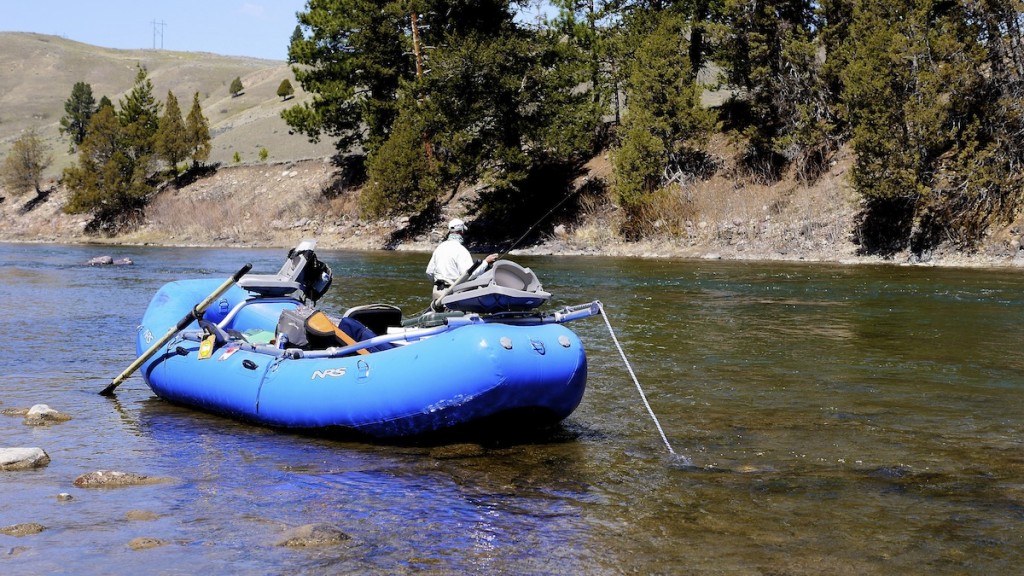Pre runoff is one of our favorite times of year. Montana is blessed with some fantastic early season fly fishing, and pre-runoff fishing can be some of the most reliable fishing over the course of the season. The water will be low and clear, the fish are feeding voraciously, and with a little luck you’ll hit some of the first big hatches of the year.
You don’t hear the term “pre-runoff” applied to tailwater rivers like the Missouri or Bighorn. The term is typically reserved for the states freestone rivers. When someone mentions “pre-runoff” fishing, my mind quickly thinks of the Big Hole, Bitteroot, Yellowstone or Blackfoot rivers. Rivers that I’ve experienced exceptional dry fly and streamer fishing prior to runoff in May and June.
Our fishing on the Missouri is excellent during late March, April and May. It is very consistent and reliable for the same reason that freestone rivers fish well at that time. While we do receive runoff, we typically can fish right through it. Fishing often improves during our runoff.
On freestone rivers, the term runoff usually refers to “un-fishable” conditions due to snowmelt. Rivers often come in and out of shape during the spring as low level snowmelt and rain bump up the flows. These small increases often last only a few days, and fly fishing is often excellent in the windows of clear water in-between. Sometime in May or June, the river comes up and stays up, as warm temperatures liquify our higher elevation snowmelt. Freestone rivers will become un-fishable for 2 to 6 weeks during this time.
Above image: Lt. Dan searching the Blackfoot River with a streamer during April.
Locally, the Blackfoot River is our most popular pre-runoff freestone fishery. While we have excellent – and popular – fishing during April and May, the Blackfoot offers something different. You might encounter Skwala or March Brown hatches that offer summer-like dry fly fishing. Throwing giant streamers can result in some enormous Brown Trout, and a possible encounter with a large Bull Trout.
Nymphing is the go to method in the morning as water temperatures are still quite cool, but as the water warms in the afternoon the trout become more aggressive and will chase the streamer. Like summer, some humid and cloudy afternoon conditions will trigger the first big hatches of the year. When you hit it right, you’ll often encounter some stupid dry fly fishing.
Other west-side rivers like the Clark Fork and Bitteroot offer fantastic pre-runoff fishing as well, but can be more crowded as anglers from all over attempt to hit the Skwala hatches the Missoula area is famous for. Chasing any stonefly hatch can be a gamble, so we always recommend that you look for the best conditions and just go fishing. You might miss the Skwala’s, but you might hit some great streamer fishing with little to no competition.
In SW Montana, the Big Hole River is an excellent pre-runoff destination. March Brown’s and Skwala’s are also present here, and the streamer fishing can off the charts. The “Craig-ish” village of Melrose is a great place to hang as well. I’ve always preferred some of the lower Big Hole floats in the spring (Melrose downstream).
The Yellowstone is another east-side river that puts out some great pre-runoff fishing. Early baetis and midges can offer some great fishing in March and April, and when it comes to catching big fish on streamers, the Yellowstone is on the top of the list.Like the Missouri River, the Yellowstone can experience some fierce winds that make spring fishing not-so-fun, so watch the weather.
You can also find some great wade fishing on some of the small and medium sized rivers in the state. Remember to check the regulations before fishing, as it is not uncommon for smaller streams – or stretches of them – to be closed until the opener in May.


2 Comments.
Hey there. I really enjoyed this information. I live down in CO, and my buddy and I bought a float boat this offseason and are looking to have some adventures this summer before his first child is born. I would love a bit more information about where we should put in, and take out, as we are very novice rowers, as well as the time that those hatches you mentioned typically happen. Everything about your description seems ideal! Thanks for your help!
Drew
Drew – Really hard to say where to put in and take out this far ahead of time. It’s best to wait until the day you go and make a decision based on wind, water flows, weather and recent reports. For novice rowers it gets no easier than the Missouri River, and all of our floats would considered safe for new rowers. I would get at least a few days under my belt before trying the Blackfoot or Big Hole. Or maybe hire a guide for one day so you can see what it’s like. The lower Yellowstone should be pretty straightforward if the flows are low, as is the Madison river – though you’ll probably hit a few rocks in that new boat. The lower Clark Fork around St. Regis is another safe spot for rookies if the water is low. The Bighorn is very mellow and the closest to you. It’s a no-brainer during springtime. great fishing and easy rowing. I suggest calling any of the fly shop near those rivers shortly before your trip and getting the most up to date information on flows, stretches to float, fishing conditions, etc.